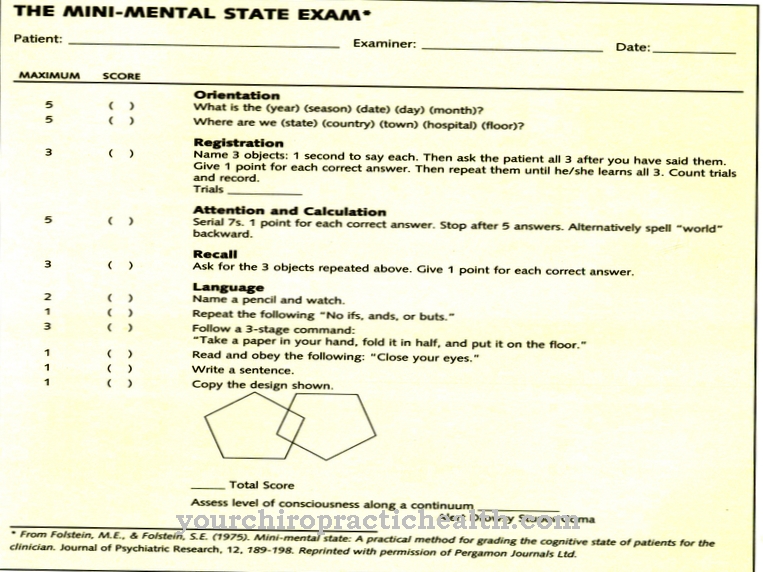Under a Intelligence test a scientific instrument is understood, which serves to determine the intelligence quotient of a test person. In the following, the term intelligence test is defined in more detail and its field of application and its application methods are described with regard to function, effect and goals. Furthermore, risks, side effects, dangers and special features of intelligence tests are discussed.
What is the intelligence test?

The term intelligence test is a psychological procedure that is used to determine a person's intelligence. This is done by means of various problems and tasks that have to be solved. Based on the result, the person is then rated in comparison with all other participants.
However, because there are different theories about what intelligence is, there are also different intelligence tests. However, what most of them have in common is that the result is represented by the intelligence quotient, or IQ for short. In Germany, people with an IQ of 130 or more are considered gifted. When evaluating an intelligence test, it is important to note which theory the test is based on. Accordingly, such a test either deals with a general intelligence or with different components.
General intelligence is determined by the number connection test by Erwin Roth or the matrix test by John C. Raven. According to a theory of the British-American psychologist R. B. Cattell, intelligence can be divided into fluid intelligence and knowledge. Problem-solving skills and acquired knowledge are compared. Depending on the severity of the test person, the result is important for clinical or developmental psychology.
Function, effect & goals
The field of application of intelligence tests extends from personnel selection and career advice to the recommendation of a possible school career to medical diagnostics. It is possible to determine suitability for certain professions in advance using intelligence tests. An intellectual disorder, mental disorder or dementia can also be detected. Accordingly, there are different tests for different age groups.
The best-known test for children from two and a half to twelve and a half years is the Kaufmann Assessment Battery for Children, or K-ABC for short. However, the successor version KABC II has existed in Germany since the end of 2014, as intelligence tests have to be checked regularly and, if necessary, recalibrated due to the changing average intelligence measured. The new version is aimed at children and adolescents from three to eighteen years of age and, in addition to training and job-related aptitude and rehabilitation diagnostics, also provides development diagnostics in early childhood and neuropsychological diagnostics.
The KABC II is based on the theory of crystalline and fluid intelligence. It consists of sixteen sub-categories from which a selection is made depending on the age of the test person. There is also a language-free test for people with severe hearing impairment or language skills, as well as poor language skills. The Kaufmann test for measuring intelligence for adolescents and adults has also been available since 1997. This is based on the same theory, but has only eight sub-categories.
Another speech-free intelligence test is the aforementioned John C. Raven matrix test. This is based on the theory of general intelligence and consists of patterns that must be recognized and continued. The Hamburg-Wechsler intelligence test for adults is also very popular, and there is also a version for children and adolescents. It consists of ten sub-tests that can be divided into four different scales. The division is made into the areas of speech understanding, perceptual logical thinking, working memory and processing speed. There are several different tests that deal with different components of intelligence, i.e. they do not assume general intelligence.
The best known are the Berlin Intelligence Structure Test, the Intelligence Structure Test and the Wild Intelligence Test in the second version. All three deal, among other things, with the speech, arithmetic and memory skills of the test subjects. Intelligence tests are limited in time and must be carried out under the supervision of a qualified psychologist. This is particularly important if such a test is carried out as part of an assessment center, otherwise the result can be contested.
You can find your medication here
➔ Medicines against memory disorders and forgetfulnessRisks, side effects & dangers
It should be noted that due to the various theories of intelligence, but also due to cultural and linguistic differences, there can be no general intelligence test. Although all results are given with the IQ, they are not directly comparable. Since different aspects are tested, not all measured values are synonymous. In addition, due to normalization and calibration, the tests themselves cannot be compared with one another.
This makes it even more difficult to make a cross-border or cultural comparison of the IQ scores achieved. Often the willingness to take part in such a test procedure is extremely low in societies in which there is no realistic reference to it. In the case of language-related variants, people with poor language skills often do poorly. There are also non-language tests, such as the above-mentioned matrix test or the Culture Fair Test CFT, but even with these, the success is strongly culture-dependent. However, it is not only the language or cultural background that is important for successfully completing an intelligence test.
Children from the upper social classes achieve better results on such tests than children from the working or lower classes. Whether this is because the test items are unfair to such children is currently being discussed. The so-called Minnesota Mechanical Assembly Test, on the other hand, does not measure in the traditional way, but relates to mechanical capabilities. Children from the lower class do a little better than their peers from the middle or upper class. Furthermore, while the test results are accurate, they are not entirely accurate. Minor measurement errors must always be taken into account.



























